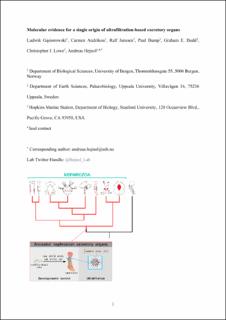| dc.contributor.author | Gasiorowski, Ludwik | |
| dc.contributor.author | Andrikou, Carmen | |
| dc.contributor.author | Bump, Paul | |
| dc.contributor.author | Lowe, Christopher J. | |
| dc.contributor.author | Janssen, Ralf | |
| dc.contributor.author | Budd, Graham E. | |
| dc.contributor.author | Hejnol, Andreas | |
| dc.date.accessioned | 2021-09-08T12:06:14Z | |
| dc.date.available | 2021-09-08T12:06:14Z | |
| dc.date.created | 2021-06-25T15:00:31Z | |
| dc.date.issued | 2021 | |
| dc.identifier.issn | 0960-9822 | |
| dc.identifier.uri | https://hdl.handle.net/11250/2774635 | |
| dc.description.abstract | Excretion is an essential physiological process, carried out by all living organisms, regardless of their size or complexity.1, 2, 3 Both protostomes (e.g., flies and flatworms) and deuterostomes (e.g., humans and sea urchins) possess specialized excretory organs serving that purpose. Those organs exhibit an astonishing diversity, ranging from units composed of just few distinct cells (e.g., protonephridia) to complex structures, built by millions of cells of multiple types with divergent morphology and function (e.g., vertebrate kidneys).4,5 Although some molecular similarities between the development of kidneys of vertebrates and the regeneration of the protonephridia of flatworms have been reported,6,7 the molecular underpinnings of the development of excretory organs have never been systematically studied in a comparative context.4 Here, we show that a set of transcription factors (eya, six1/2, pou3, sall, lhx1/5, and osr) and structural proteins (nephrin, kirre, and zo1) is expressed in the excretory organs of a phoronid, brachiopod, annelid, onychophoran, priapulid, and hemichordate that represent major protostome lineages and non-vertebrate deuterostomes. We demonstrate that the molecular similarity observed in the vertebrate kidney and flatworm protonephridia6,7 is also seen in the developing excretory organs of those animals. Our results show that all types of ultrafiltration-based excretory organs are patterned by a conserved set of developmental genes, an observation that supports their homology. We propose that the last common ancestor of protostomes and deuterostomes already possessed an ultrafiltration-based organ that later gave rise to the vast diversity of extant excretory organs, including both proto- and metanephridia. | en_US |
| dc.language.iso | eng | en_US |
| dc.publisher | Elsevier | en_US |
| dc.rights | Attribution-NonCommercial-NoDerivatives 4.0 Internasjonal | * |
| dc.rights.uri | http://creativecommons.org/licenses/by-nc-nd/4.0/deed.no | * |
| dc.title | Molecular evidence for a single origin of ultrafiltration-based excretory organs | en_US |
| dc.type | Journal article | en_US |
| dc.type | Peer reviewed | en_US |
| dc.description.version | acceptedVersion | en_US |
| dc.rights.holder | Copyright 2021 Elsevier | en_US |
| cristin.ispublished | true | |
| cristin.fulltext | postprint | |
| cristin.qualitycode | 2 | |
| dc.identifier.doi | 10.1016/j.cub.2021.05.057 | |
| dc.identifier.cristin | 1918577 | |
| dc.source.journal | Current Biology | en_US |
| dc.source.pagenumber | 3629-3638.e2 | en_US |
| dc.subject.nsi | VDP::Systematisk zoologi: 487 | en_US |
| dc.subject.nsi | VDP::Systematic zoology: 487 | en_US |
| dc.subject.nsi | VDP::Systematisk zoologi: 487 | en_US |
| dc.subject.nsi | VDP::Systematic zoology: 487 | en_US |
| dc.subject.nsi | VDP::Systematisk zoologi: 487 | en_US |
| dc.subject.nsi | VDP::Systematic zoology: 487 | en_US |
| dc.subject.nsi | VDP::Systematisk zoologi: 487 | en_US |
| dc.subject.nsi | VDP::Systematic zoology: 487 | en_US |
| dc.identifier.citation | Current Biology. 2021, 31(16), 3629-3638.e2 | en_US |
| dc.source.volume | 31 | en_US |
| dc.source.issue | 16 | en_US |

